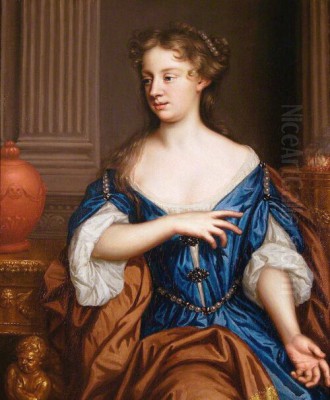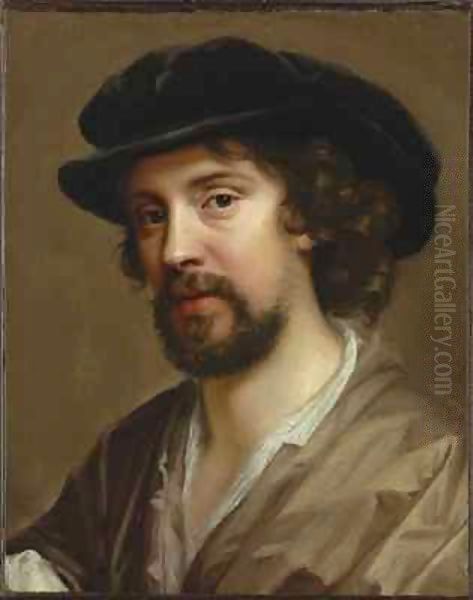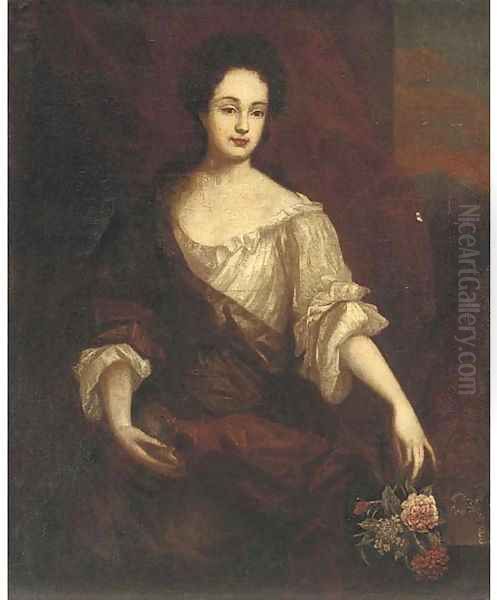Introduction: A Foremost Female Artist

Mary Beale, born Mary Cradock in 1633 and passing away in 1699, stands as a pivotal figure in the history of British art. Widely recognized as one of the most distinguished professional female painters of the early modern period in England, she is often celebrated as the country's first truly successful woman artist operating on a professional basis. In an era overwhelmingly dominated by male practitioners, Beale carved out a significant career, primarily as a portraitist, gaining considerable acclaim and patronage within London's elite circles during the latter half of the 17th century. Her life and work offer invaluable insights not only into the artistic practices of the Restoration era but also into the challenges and triumphs faced by women seeking professional independence.
Early Life and Artistic Formation in Suffolk
Mary Cradock was born in the village of Barrow, Suffolk. Her father, John Cradock, served as the local rector. Significantly, he was also an amateur painter, suggesting that Mary's initial exposure to the visual arts likely occurred within her own home. This early familial encouragement was crucial, especially given that her mother passed away when Mary was still young. While formal artistic apprenticeships were largely inaccessible to women at the time, it is highly probable that John Cradock provided his daughter with her foundational training in drawing and painting techniques.
Her formative years in Suffolk laid the groundwork for her later artistic development. Beyond direct instruction from her father, the environment likely fostered observation and practice. The snippets suggest she honed her skills partly by studying and copying the works of established masters. This method of self-education, centered on emulation, was a common pathway for aspiring artists, particularly those outside the formal guild or academy structures. This early grounding in the fundamentals, combined with an innate talent, prepared her for the more competitive artistic environment she would later encounter.
Marriage, Partnership, and the Family Enterprise

In 1652, Mary Cradock married Charles Beale, a cloth merchant from London who also possessed an interest in art and practiced painting as an amateur. This union proved to be exceptionally supportive and collaborative, playing a critical role in Mary's professional success. Charles Beale recognized his wife's superior talent and ambition. At a certain point, particularly as Mary's reputation grew, he made the remarkable decision to relinquish his own career pursuits to act as her full-time studio manager and business assistant.
This partnership was fundamental to the operation of the Beale studio. Charles took responsibility for a wide range of practical tasks: he prepared canvases and palettes, sourced and ground pigments, managed commissions, liaised with clients, handled finances, and meticulously recorded the studio's activities. His detailed almanacs or notebooks, kept particularly during the 1670s and early 1680s, provide an unparalleled documentary record of a 17th-century artist's working life. They list sitters, track paintings produced, note technical experiments, record payments received, and even offer glimpses into the family's social life.
The Beale household effectively functioned as a family business, with Mary's artistic output as its core economic engine. Her earnings supported the family, a significant achievement for a woman in that period. This unique domestic and professional arrangement, built on mutual respect and shared goals, enabled Mary to dedicate her time and energy primarily to the act of painting, freeing her from many of the administrative burdens that could otherwise hinder artistic production. Their sons, Bartholomew and Charles Jr., also grew up within this artistically charged environment.
Launching a Professional Career in Portraiture
Mary Beale began working as a semi-professional portraitist around the mid-1650s. Her talent quickly gained recognition, and she transitioned into becoming a full-time professional artist, a status few women achieved in 17th-century England. Her primary focus was portraiture, the most lucrative and socially prestigious genre for artists at the time. She catered to a distinguished clientele drawn from London's burgeoning middle class, intellectual circles, the clergy, and the gentry, though perhaps less frequently the highest echelons of court aristocracy dominated by painters like Sir Peter Lely.
Her circle of patrons and friends included prominent figures such as John Tillotson, who later became Archbishop of Canterbury, the poet Thomas Fairman, and other intellectuals, clergymen, and members of the social elite. The ability to attract such sitters speaks volumes about her reputation and the quality of her work. Her studio, particularly during its peak years in the 1670s when the family resided in London locations like Pall Mall, became a hub not just for painting but also for social interaction among her circle.

Beale commanded respectable prices for her work, reflecting her professional standing. The provided information notes that a head-and-shoulders portrait might cost £5, while a larger three-quarter length format could be £10. These fees placed her comfortably within the ranks of successful London painters, though perhaps slightly below the very top tier occupied by court painters. Her consistent output and ability to secure commissions underscore her business acumen, undoubtedly aided by Charles's diligent management.
Artistic Style: Influences and Individuality
Mary Beale's artistic style is firmly rooted in the Baroque portraiture traditions prevalent in England during the Restoration period. Her work is characterized by a strong sense of realism, a sensitive rendering of her sitters' features and psychology, and a notable skill in the use of color. She paid close attention to detail in depicting fabrics and textures, while often employing relatively direct poses and compositions. Her brushwork could be both delicate and assured.
The most significant artistic influence on Mary Beale was undoubtedly Sir Peter Lely, the dominant court painter in England following the Restoration of King Charles II. Lely, who had himself inherited the mantle from the earlier Flemish master Sir Anthony van Dyck, established a highly fashionable style characterized by rich colors, elegant poses, and a certain languid grace. Beale knew Lely personally, likely through her husband Charles, and was granted the valuable privilege of observing him work in his studio.
She actively studied Lely's techniques and compositions, often making copies of his paintings as a learning exercise. Her husband Charles's notebooks document instances of purchasing pigments from Lely and even acquiring some of Lely's studio props or templates for poses. This close association led some contemporaries, and later critics, to suggest that her style was overly derivative of Lely's. However, while the influence is undeniable, Beale's work often possesses a distinct character – perhaps a greater degree of directness, a plainer presentation, or a more intimate psychological connection with the sitter, particularly evident in her portraits of family and close friends. Some sources also mention an "Italianate" quality, suggesting an awareness of continental European trends, possibly absorbed through prints or contact with other artists.
Interestingly, her style was sometimes described by contemporaries using the term "masculine," which, in the context of the 17th century, was often intended as high praise, implying strength, vigor, and technical competence comparable to her male counterparts. Despite occasional criticisms regarding originality, her ability to absorb influences like Lely's while maintaining her own artistic voice contributed significantly to her success. She navigated the expectations of the market while developing a recognizable hand.
Studio Practice, Techniques, and Writings

The Beale studio was a site of diligent practice and methodical production, thanks in large part to the organizational efforts of Charles Beale. His preparation of materials ensured Mary could work efficiently. The practice of copying works by masters like Lely, or potentially earlier figures like Van Dyck whose influence permeated the era, was not just for learning but sometimes also served as a way to provide clients with versions of admired compositions. The use of pose templates, as noted in connection with Lely, was a standard studio practice aimed at increasing efficiency for popular portrait formats.
Mary Beale was not only a practitioner but also an intellectual engaged with the theory and discourse surrounding her craft. She authored a manuscript titled "Observations," sometimes referred to as "Observations on Painting in Oil." Although seemingly not published during her lifetime, this work is historically significant as potentially the first text on the techniques of oil painting written by a woman. It demonstrates her reflective approach to her art and her desire to articulate her methods and understanding.
Furthermore, some sources attribute to her a manuscript titled "A Discourse on Friendship," which explored themes of equality and companionship, possibly reflecting her own egalitarian marriage and her engagement with the intellectual currents of her time. These writings position Beale not just as a skilled painter but as a thinking artist contributing to the cultural life of her period beyond the canvas. Her studio was more than a workshop; it was a space where art, business, and intellectual exchange converged.
A Circle of Friends, Patrons, and Contemporaries
Mary Beale operated within a vibrant social and intellectual network in London. Her success was built not only on talent but also on cultivating relationships with patrons and peers. Her husband Charles's connections initially helped, but Mary's own abilities and personality sustained these relationships. Her circle included influential figures in the Church of England, such as Edward Stillingfleet (later Bishop of Worcester) and John Tillotson, both of whom sat for portraits.
She was also friends with writers and fellow artists. The miniature painter Thomas Flatman was a close associate, and the poet Samuel Woodford was part of her circle. These connections provided commissions, fostered intellectual exchange, and helped solidify her professional standing. Her studio gatherings, where friends and clients could view works in progress, discuss art and literature, and socialize, were likely important for maintaining her visibility and network.

Within the broader London art scene, Beale was a contemporary of several other notable painters. Besides the towering figure of Sir Peter Lely, other portraitists active during parts of her career included Gerard Soest, John Riley (who competed with Godfrey Kneller after Lely's death), Michael Wright, Jacob Huysmans, and Willem Wissing (Lely's talented assistant). Later in her career, Sir Godfrey Kneller rose to prominence, eventually succeeding Lely as the leading court painter. While Beale primarily served a different segment of the market than the main court painters, she operated within this competitive environment. It's also worth noting Joan Carlile, another English woman portraitist active slightly earlier in the century, though Beale achieved greater sustained professional success. Earlier figures like Robert Walker (prominent during the Commonwealth) and Isaac Fuller were also part of the artistic landscape she navigated. The influence of Sir Anthony van Dyck, though he died in 1641, continued to shape portraiture throughout Beale's lifetime.
Teaching, Mentorship, and Artistic Lineage
Mary Beale played a role in fostering the next generation of artists, particularly women, which was unusual for the time. She took on pupils in her studio, providing them with training and professional opportunities. The sources mention Sarah Curtis (sometimes written as Cut(t)i(e)s or perhaps confused with Keaty Trioche in some accounts) as one of her principal students. Sarah Curtis lived with the Beale family for a period and went on to become a professional painter herself, demonstrating a direct line of artistic transmission. Training young women was a significant act, offering them a pathway into a profession largely closed off to them.
Her pedagogical impulse also extended to her own family. Her son, Charles Beale Jr., received artistic training from his mother and initially pursued a career as a painter, specializing in miniatures. His style clearly shows her influence. Although he later shifted his focus to medicine, his early work stands as a testament to the artistic environment fostered within the Beale household. This commitment to teaching, both within and outside her family, highlights Beale's role not just as a creator but also as an enabler of artistic talent.
Representative Works: Capturing Likeness and Intimacy
While Mary Beale produced a large number of portraits throughout her career, certain works stand out or are frequently cited. Her portraits of her own family members are often considered among her most compelling, perhaps because they allowed for a greater degree of intimacy and less formal constraint than commissioned works.
The portrait titled Bartholomew Beale, depicting her young son around the age of four (c. 1663-64), is noted for its tender observation and sensitive portrayal of childhood. It showcases her skill in capturing not just a physical likeness but also a sense of the sitter's personality, even at a young age.
Her Self-Portrait (various versions exist) offers insight into how she presented herself – typically as a serious professional, sometimes holding the tools of her trade. These images are crucial documents of female artistic identity in the 17th century.

The portrait of her husband, Charles Beale (c. 1680), is another significant work, reflecting their close partnership. Often depicted with warmth and directness, these portraits underscore the personal dimension of her art.
Beyond her family, portraits of key patrons like John Tillotson, Archbishop of Canterbury, demonstrate her ability to capture the gravitas and intelligence of prominent public figures. While often adhering to the conventions of Baroque portraiture influenced by Lely, these works still convey Beale's characteristic attention to likeness and her skillful handling of paint. Many other portraits of clergy, gentry, and intellectuals survive, collectively showcasing the breadth of her practice and the esteem in which she was held.
Later Life, Death, and Enduring Legacy
Mary Beale enjoyed considerable success, particularly during the 1670s. However, the later years of her career saw some decline in popularity. Artistic fashions began to change, particularly after the death of Sir Peter Lely in 1680 and the subsequent rise of Sir Godfrey Kneller, whose style offered a newer, perhaps more flamboyant, alternative that captured the taste of the late Stuart and early Georgian periods. Increased competition and shifting patronage patterns likely affected her commissions.
Despite any later decline in fashion, Mary Beale continued to paint until shortly before her death. She passed away in London in 1699 and was buried at St. James's Church, Piccadilly.
Her legacy is multifaceted. Artistically, she left behind a substantial body of work that provides valuable documentation of Restoration-era society and stands as a testament to her skill as a portraitist. Historically, she holds a crucial place as arguably the first English woman to sustain a long and successful career as a professional painter, operating her studio essentially as a business enterprise. She demonstrated that a woman could achieve artistic recognition and financial independence through her craft in a male-dominated field.
The detailed records kept by her husband, Charles Beale, are an invaluable resource for art historians, offering rare insights into the day-to-day operations, materials, techniques, and finances of a 17th-century artist's studio. Mary Beale's life story, balancing the roles of wife, mother, and professional artist, serves as an important early example of female achievement in the arts. Her work, after a period of relative obscurity following her death, has been increasingly recognized and studied, securing her position as a significant figure in British art history.
Conclusion: A Trailblazer in British Art
Mary Beale's career represents a remarkable achievement in 17th-century English art. Emerging from a supportive family background, she leveraged her talent, determination, and a unique partnership with her husband to build a successful professional practice in the competitive world of London portraiture. Influenced by masters like Sir Peter Lely, she developed a distinctive style characterized by realism, sensitivity, and skillful technique. Her circle of patrons and friends included prominent figures, and her studio served as both a workshop and a social hub. Beyond her own prolific output, she contributed to art discourse through her writings and fostered talent through teaching. As a pioneering female professional, Mary Beale not only created a significant body of work but also paved the way for future generations of women artists, leaving an indelible mark on the history of British art. Her life and work continue to be celebrated for their artistic merit and historical significance.